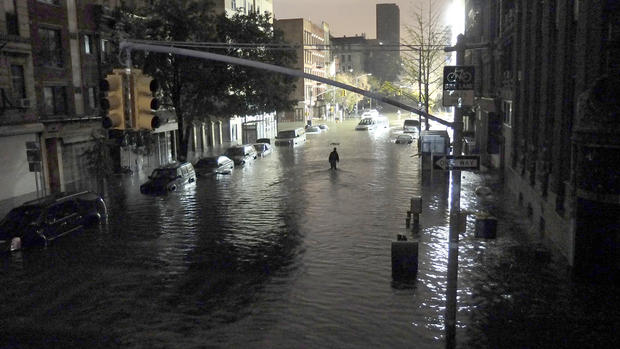Superstorm Sandy aftermath: How to stay safe
More than 7.6 million homes across the East Coast in Superstorm Sandy's path have lost power, and many are still at risk as the storm front moves inland.
One of the hardest hit areas, New York City, had about 750,000 residents still without power on Tuesday morning.
"This will be one for the record books," John Miksad, senior vice president for electric operations at Consolidated Edison, said to the Associated Press. Consolidated Edison generates the power for most of the New York City area.
New York City Mayor Michael Bloomberg added at a press conference on Tuesday morning that it may take two to three days for power to return to affected areas.
- Superstorm Sandy slams East Coast, leaving floods, millions without power
- Superstorm Sandy could boost hiring
- The entertainment industry takes a hit as Sandy wreaks havoc
While the power is out, the food in your refrigerator and freezer may be going bad. Your fridge can keep food cold for up to four hours if unopened, and your freezer can keep food cold for 48 hours if its full (24 hours if half-full,unopened). Grouping foods together can help keep them colder, and if you have coolers and ice, you can salvage some food while your power is out. If you can buy dry ice or block ice, you can keep your refrigerator and freezer cold.
Not all of your food needs to be lost forever because the power is out. Check out FoodSafety.gov's list of refrigerated and frozen food that may be safe even without electricity. For more on food safety during and after the storm, check out CBSNews.com's checklist.
One good piece of news for many New Yorkers was when Mayor Bloomberg said city tap water has been deemed safe, so people who have running water in New York City can drink safely. However, if you live in a building that water has been shut off and don't have bottled water, you may be able to use the remaining water in your taps, which should be clean, granted your electricity and hot water have been turned off, according to the Rhode Island Department of Health.
You can also purify questionable water by using eight drops of liquid chlorine bleach per one gallon clear water or 16 drops per one gallon of clouding water, the Connecticut Department of Health reported. Bleach should not have any perfumes or any ingredients besides sodium hypochlorite. You can also boil the water at a constant, rolling boil for one minute if possible. Make sure the water has no floating pieces in it, and let it sit for 30 minutes before consuming.
Do not drink tap water until it has been cleared by local authorities and well water unless it has been tested for total coliform bacteria, or bacteria found in the fecal mater of warm-blooded animals or organisms. While coliform bacteria do not cause illness, they usually indicate that there are other bacteria prthat do.
For more on safe drinking water tips, click here.
In case of any emergency, the CDC recommends you always have these items on hand.
- Several clean containers of water, large enough for a three-to-five day supply -- a gallon per person per day
- A supply of non-perishable foods that can last up to five days. Non-perishable foods may include peanut butter, protein bars, dry cereal or granola, nuts, crackers, canned juices and ready-to-eat canned meats, fruits and vegetables
- A first aid kit and manual
- A battery-powered radio, flashlights, and extra batteries
- Sleeping bags, extra blankets
- Water-purifying supplies, such as chlorine or iodine tablets or unscented, ordinary household chlorine bleach
- Prescription medicines and special medical needs
- Baby food and/or prepared formula, diapers, and other baby supplies
- Disposable cleaning cloths, such as "baby wipes" for the whole family to use in case bathing facilities are not available
- Personal hygiene supplies, such as soap, toothpaste, sanitary napkins, etc.
Read CBSNews.com's coverage of disaster preparedness for more tips for those awaiting the storm.
